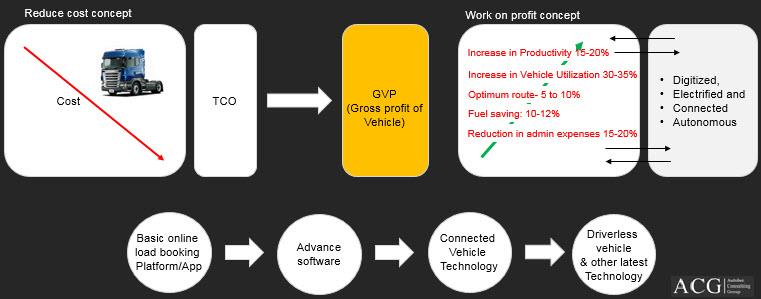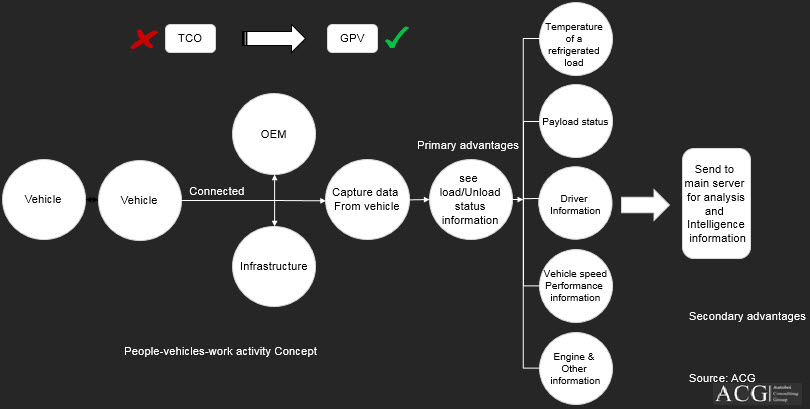"The replacement of TCO by GPV calculator foreseen"
"Sit back and let me take you forward into the future, to see what the year 2030 holds in store.
but trucks lightyears ahead in technology from what we see on the road today.'
By the year 2030, our transportation system will have reached a whole new level: intricately connected; and above all, significantly more efficient and effective".
The future of Commercial vehicles lies in digitized, electrified, safe, efficient, automated and well-connected Trucks and Buses.
The Global CV Industry is geared up to witness some major changes in the next ten years. The industry is very interested to see the impact of these changes, mainly on Transport system, OEMs Strategy, Vehicle Configuration, Suppliers technology, Customers, Productivity, Profit etc. This industry's dynamic market will change in correspondence with the new approaches it takes in order to realise this.
Every Tom, Dick and Harry's current focus is on cost cutting solutions. Using that as the major criteria, Global TCO has managed to stretch it's dictatorial webs all over the scenario reaching even the farthest corners and nooks of the world. This was one of the most important buying factors in Traditional approaches. With the advent of technological advancements and innovated logistics, the stakeholders are now shifting their focus on to the GPV (Gross profit of vehicle).
The latest research carried out at ACG to analyze and inform about new trends aims to change buying opinions as its focus does not lie on cost, but profit. By choosing to do so, ACG offers better solutions to converge on increased profit and revenue. Reducing cost has always been the more tedious job when compared to increasing profit, and it adds to why we need to be concentrating on the latter than the former.
Now let us shift our focus to the working and components of the GPV.
If more transporters started following the profit making strategy, it could be a game changer for the logistics Industry, OEMs and other stake holders of this Industry. In order to increase profit, the first step is to ensure that transporters use minimum full capacity of their Trucks. This will enable them to carry more load compared to current practices. Another practice that will help in increasing revenue is making sure that return freight will also be carrying the full capacity load. This can be done by attaching more trailers or providing provisions of double loading platform. The attachment of trailers depends on rated payload of the truck and density of the material. Additionally, a recent technological innovation contributes to increasing GPV like those in the Long haulage sides that automatically open and close with the simple push of a button – delivering safety and time-saving benefits. Online freight booking also helps transporters maintain their attractive profit and increase revenue too.
The Truck Industry needs to adapt itself to the dynamic, technologically advanced scenario. Connected vehicles help all stake holders of the transporter industry to maximum utilisation of the vehicle. As communications increase, productivity will also improve and ultimately profit will be jumped ahead of the truck industry. A very new phenomenon in the current scenario is the penetration of ‘technological innovation’ in almost all areas of logistics and Commercial Vehicle Industry.
Coming to our next phase in the transportation sector, this phase loops in even the customer, who can check status of their vehicle even while it is in the production and assembly line. It's transparent market makes sure to invest all of its stakeholders.
This smart system will also work like a bridge between Demand and supply load transport in addition to helping prevent accidents. On every transport hub there will be server that will be connected to other servers in the regional transport hub. If one vehicle has a total load of weight A, it will unload weights of A/8, A/7 and A/6 to locations L1, L2 and L3. The system will now inform the next nearest server immediately to book the unload space in advance.This will facilitate an increase in GPV and better utilization of vehicle capacity. This system is very helpful for quick and economical transport of the goods also.
People will be ready to invest more if they see that the inside temperature of the vehicle is maintained and consequently, be assured that their goods will be delivered in good condition. Such systems will entrust the customer to believe in transport of the goods. The system also provides after sales support in case of any break downs in remote areas, it will immediately send help to find the vehicle and rescue the same.
It helps connect the Driveline (engine and Transmission), making them intelligent and more powerful. It allows for sensors to cleverly detect the status of parts, and share this with the workshops/ Advance garage to enable them to be better informed in advance. It also connects your vehicle to Trucks’ services centre, all in an effort to help your truck and your operation become smarter, safer and more efficient which give you better GPV.
Additionally, this system increases the GPV indirectly also by detecting drivers' drinking habits. Studies have shown that Driver’s driving habits can influence mileage between 5 to 10% less or more. It also detects if drivers need training and on what. Are they idling too much, speeding, hard braking, rough driving? This becomes an additional option, till we proceed onto the driverless vehicle future.
Digital technology also supports GPV by providing many key features. Some of the main features include Internet Digital Tachograph, the first of its kind wirelessly, combined with hands-free communication, voice guidance, and text messages displayed from the dispatch office. The system also has a password enabled vehicle theft prevention feature that will not let the vehicle start without the driver having entered a password.
Since the Tipper area of operation is limited, Tipper segment is the best segment to start integrating such technology to see how it profits the fleet owner and utilize all other advantages of this technology. After many successful testing carried out in this segment, it is now ready to be implemented on other vertical segments like Long Haulage and Buses.
Daimler, Volvo and Scania are ahead of other OEMs to integrate and have already started to use such features in their vehicles.
However, the Global CV Industry faces many more challenges like Economic Trends, Technology Trends, Society Drivers, Society regulators, Environmental trends, Suppliers trend etc.
Key Questions this Study will Answer:
– What are the key updates in the connected commercial vehicle market ? OEMs competiveness in this technology?
– Key drivers of connected vehicle Industry and trend? How trend will change market dynamics?
– Market size of Connected Cv market and outlook
– Rules and Rugulation role and its impact analysis
– How After market will adopt and use this technology?
– Customer behavior and challanges for accptance
– Opportunities and Challanges






